This Meat Temperature Chart is helpful when cooking all kinds of meats! It’s so important to know the correct internal temperatures for steak, beef, pork, salmon, fish, ground meat, and chicken for food safety. Grab this free printable meat temp guide and keep it in your kitchen to reference any time you cook!
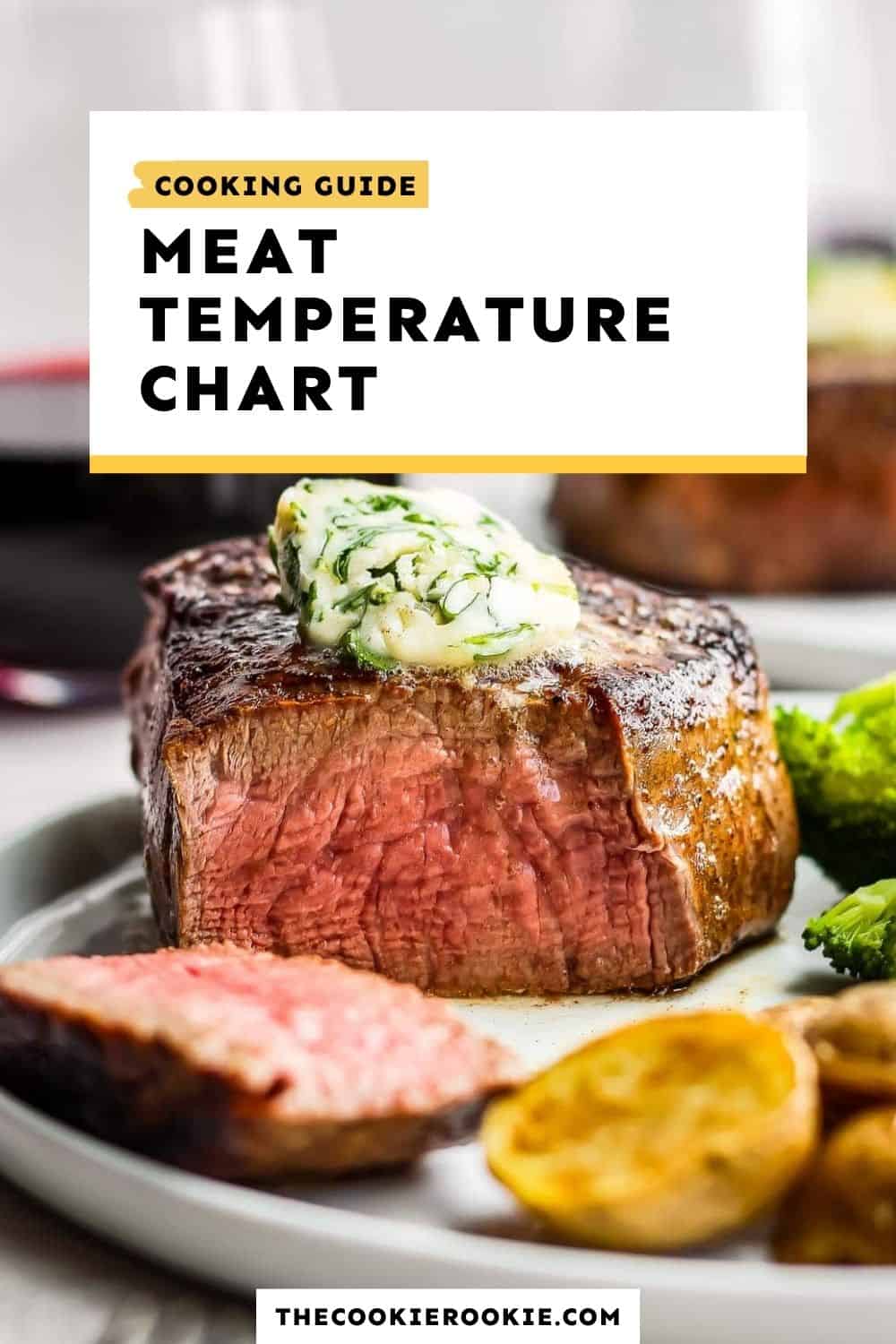
This post may include affiliate links that earn us a small commission from your purchases at no extra cost to you.
Free Meat Temperature Chart
Making sure your meat is properly cooked is essential to cooking safe and delicious recipes at home. Here you will find a free printable chart, along with lots of extra tips and info, so you always know the best cooking temperatures for chicken, beef, pork, seafood, and more!
We’ve compiled all the info we’ve gathered over the years on the perfect internal temperatures for cooking meat! This easy printable will help you when cooking beef, steak, salmon, seafood, pork, and chicken at home. Internal Temperatures are so important for keeping your family safe and your food tasting good, especially with poultry. So sit back and relax, because we’ve got you covered!
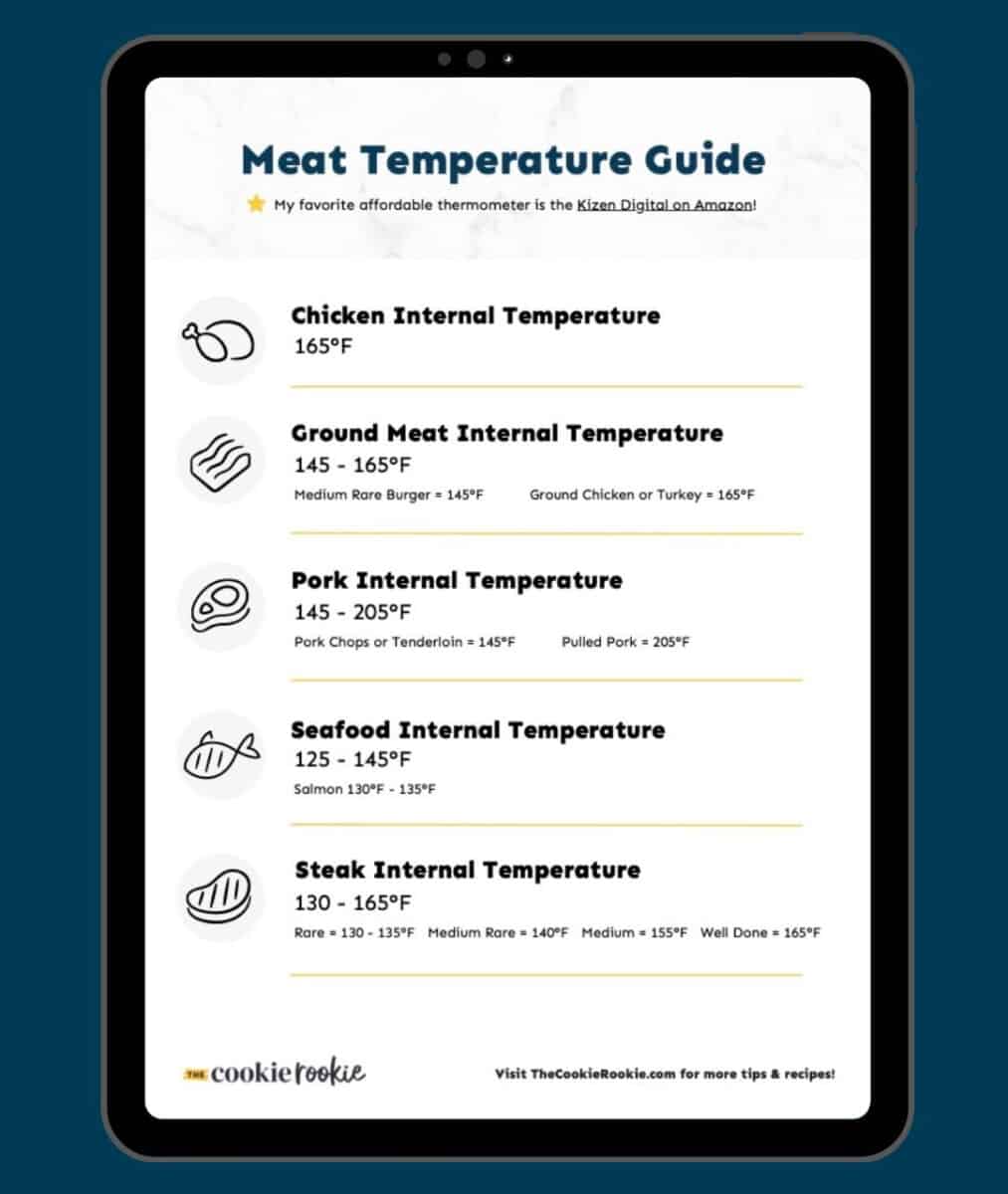

Email This Recipe
Enter your email and we’ll send the recipe directly to you!
Meat Temp Chart
Listed temperatures are the recommended minimum internal temperatures for food safety, according to the USDA. Keep reading for more details and temperatures for each type of meat.
| Meat | Internal Temp |
|---|---|
| Chicken | 165°F |
| Turkey | 165°F |
| Beef | 145°F |
| Pork/Ham | 145°F |
| Lamb | 145°F |
| Salmon/Fish | 145°F |
| Steak | 140°F |
| Ground Meat | 160°F |
| Reheated Meat | 165°F |
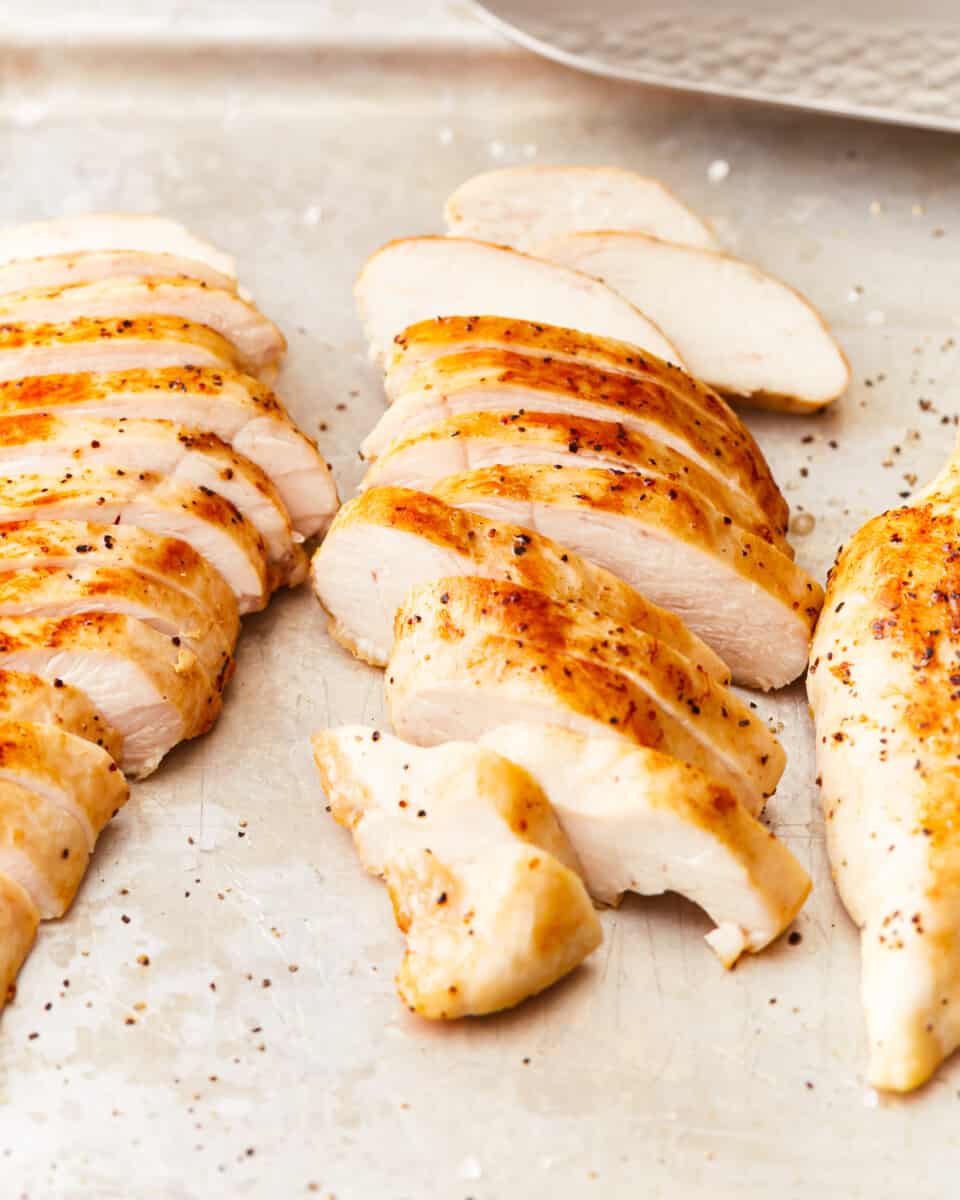
Chicken and Poultry Internal Temperature: 165°F
Cooking food to the correct internal temperature is important, especially with chicken, turkey, and other poultry. Other types of meat have some wiggle room, but the FDA & USDA are very clear that you should always cook chicken to at least 165°F to avoid salmonella poisoning.
Whether you’re making chicken breast, a whole chicken, fried chicken, chicken thighs, or another type, follow these temps.
Chicken, Turkey, and Poultry Temperature Chart
| Type | Temperature |
|---|---|
| White Meat | 165°F |
| Dark Meat | 170-180°F |
| Ground Chicken & Poultry | 165°F |
I recommend using a meat thermometer to make sure your chicken is fully cooked, but here are some extra tips to tell if it’s done:
- When you cut into the chicken, the meat should be opaque. Typically it will be white, but a little pink is okay as long as the temp is 165°F. Color doesn’t necessarily equal doneness.
- When you slice the chicken, the juices should run clear.
- The cooked chicken meat should feel firm, not jiggly or rubbery.
Some early signs of salmonella include diarrhea, chills, fever, and abdominal pain. If you fear you have food poisoning, you should always contact a doctor for further instructions.
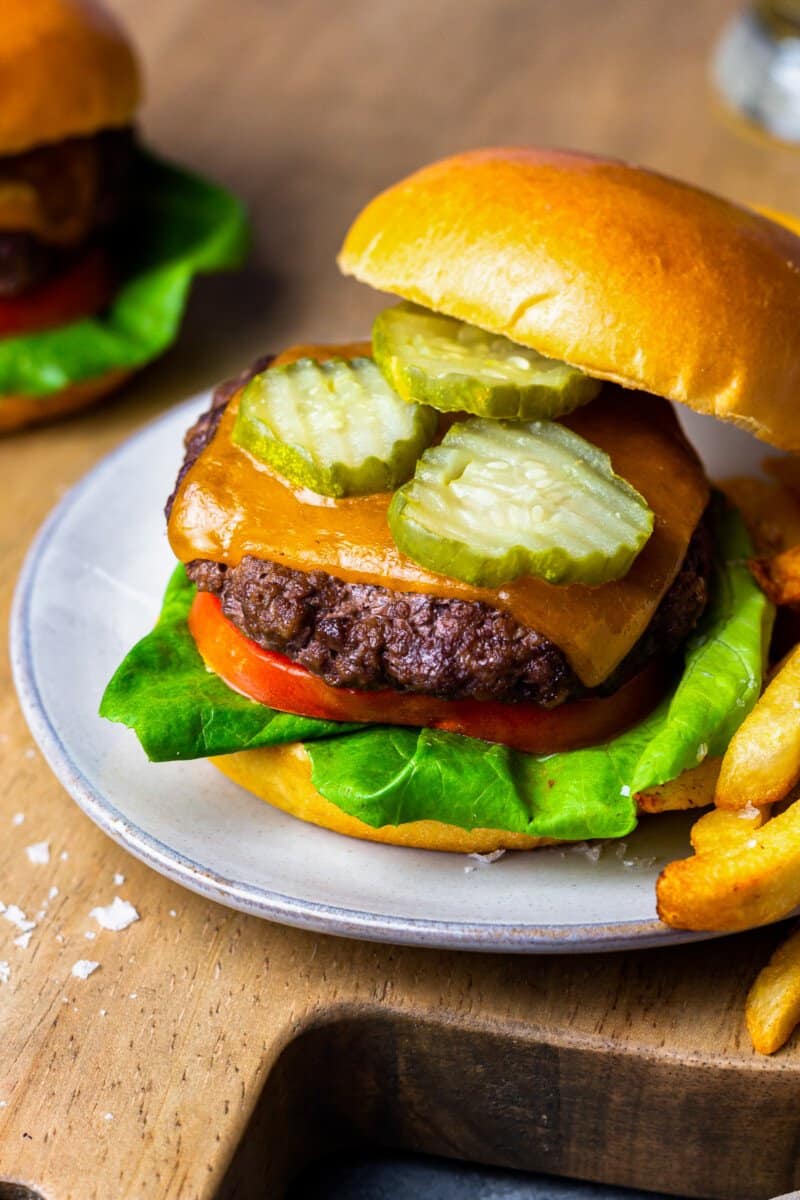
Internal Temperature of Ground Meat (burgers, meatballs, or meatloaf): 160°F
When cooking any ground beef or ground meat for recipes such as burgers, meatloaf, or meatballs, it’s recommended that you cook it to a minimum of 160°F. While it is safe to eat other cuts of beef and pork at lower temperatures, ground meat needs to be cooked to the recommended temperatures below.
Ground Meat Temperature Chart
| Type | Temperature |
|---|---|
| Ground Beef | 160°F |
| Ground Pork | 160°F |
| Ground Chicken | 165°F |
| Ground Turkey | 165°F |
A medium-rare burger would be cooked to 145°F if that’s what you prefer, but it’s officially safest to cook closer to 160°F. When meat is ground up, most of it is surface area, which exposes more of it to bacteria. So cooking it to a higher temp is recommended in order to kill all potential bacteria.
If you’re working with ground poultry (chicken or turkey), as outlined above, they should be cooked to a minimum of 165°F.
Quick Tip: When cooking with ground beef, remove from the stovetop or oven about 5 degrees under your desired internal temperature. That will help keep your recipe juicy and tender.
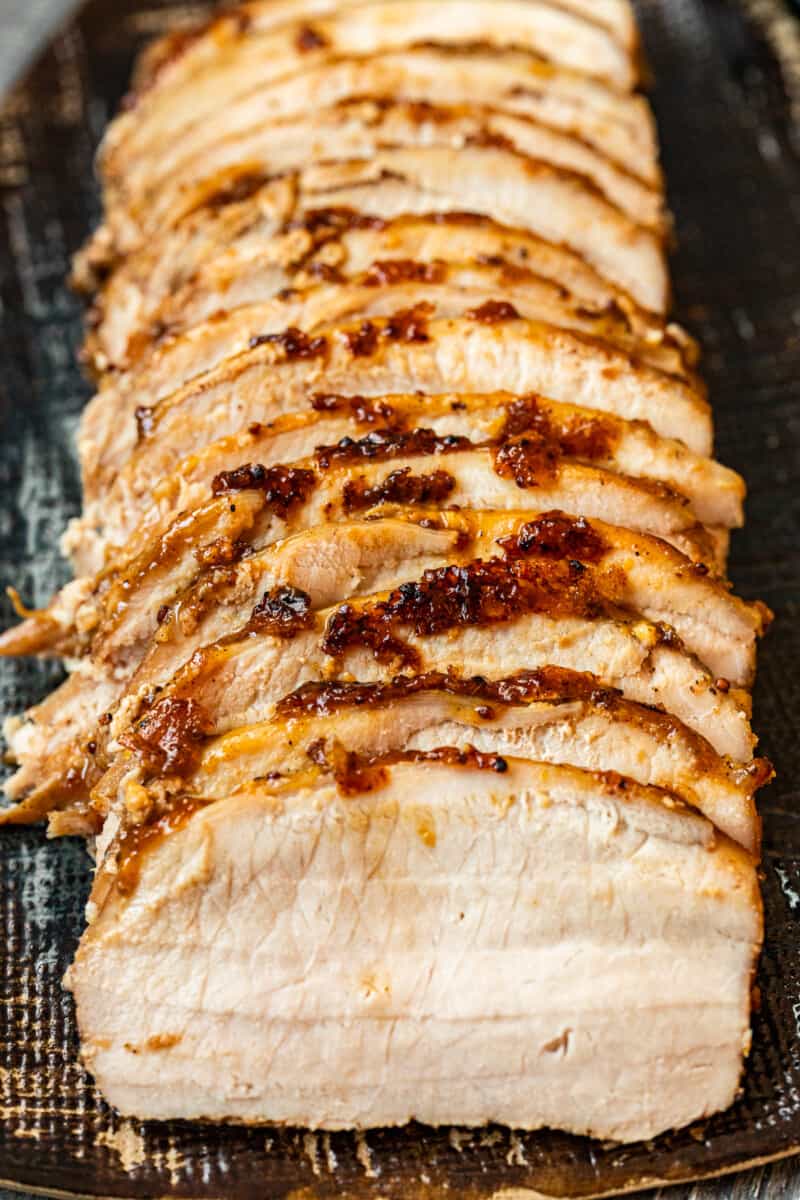
Internal Temperature for Pork (Pork Tenderloin, Ham, or Pulled Pork): 145-205°F
Pork is pretty straightforward and self explanatory when dealing with internal temperatures. The safe minimum temp for pork is 145°F, and it rarely needs to be cooked more than that. So if you’re cooking pork tenderloin or pork chops, it’s simple!
But if you’re cooking ground pork or a spiral ham, you’ll need to cook it a little longer. And pulled pork is best cooked close to 205°F for truly tender meat.
Pork Temperature Chart
| Type | Temperature |
|---|---|
| Pork Chops, Pork Tenderloin, Ham | 145°F |
| Ground Pork | 160°F |
| Pulled Pork | 205°F |
| Pre-cooked (Spiral) Ham | 165°F |
Pork is often overcooked, making it seem like it’s a more difficult meat to cook correctly. But it’s totally possible to get juicy, well-cooked pork! Just watch your temps carefully and remove from the heat about 3-5 degrees under your desired temp of 145°F, then let it rest.
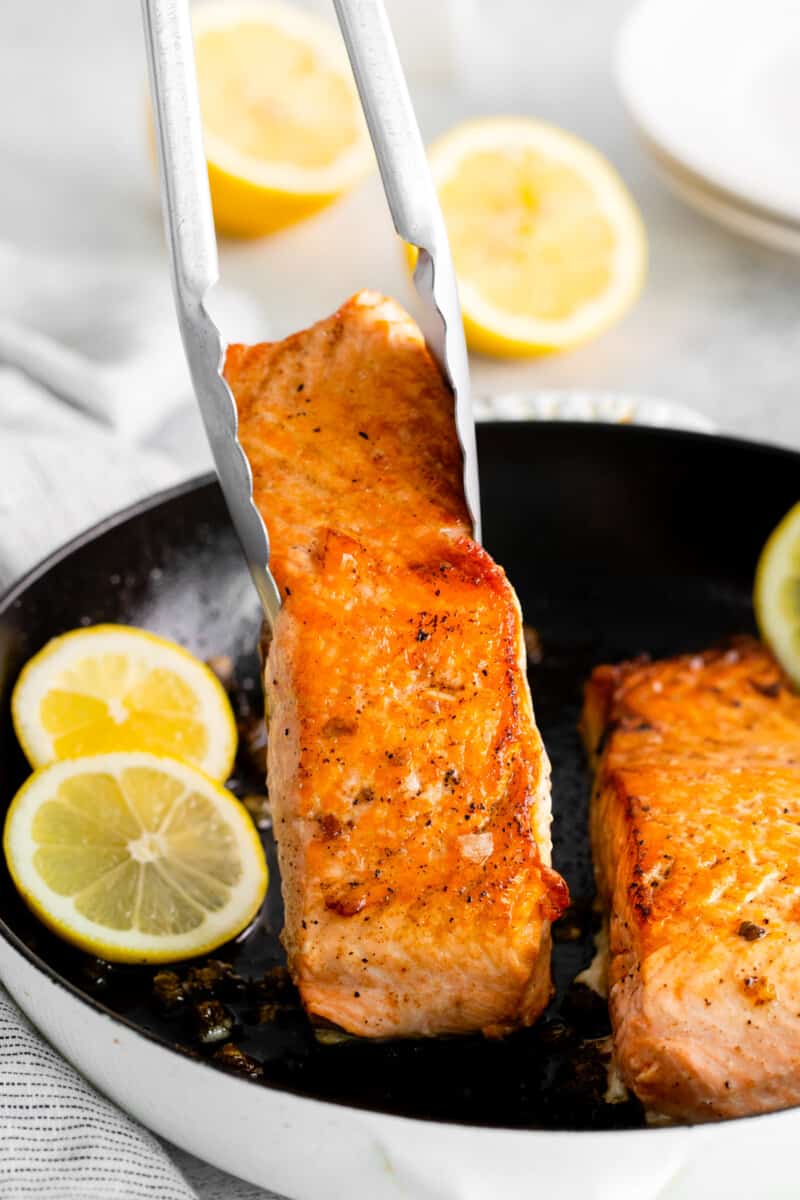
Internal Temperature for Salmon and Seafood: 125-145°F
You’re probably going to get conflicting opinions on the perfect internal temperature for salmon, fish, shellfish, and other seafood. The recommended minimum internal temp for salmon and fish is 145°F, but it is safe to cook it a bit less.
Salmon, Fish, and Seafood Temperature Chart
| Type | Temperature |
|---|---|
| Salmon and Fish | 125-145°F |
| Shellfish (Lobster, Crab, Shrimp, etc) | Cook until opaque |
I prefer to cook salmon around 130-135°F. Salmon cooked to an internal temperature of 125°F is safe to eat and is considered “medium rare”. You’ll get tender, flakey fish while being fully cooked!
All fish, like tilapia, follows the same rules as salmon. Other seafood, like lobster, crab, scallops, or shrimp, has less specific rules. You really just need to cook these foods until they become opaque, rather than checking the temp.
Quick Tip: When testing the internal temperature of salmon, be sure you’re taking the temp at the thickest part of the fillet. Remove from the heat when the fish reads about 2 degrees under your desired temperature, because it will continue to cook.
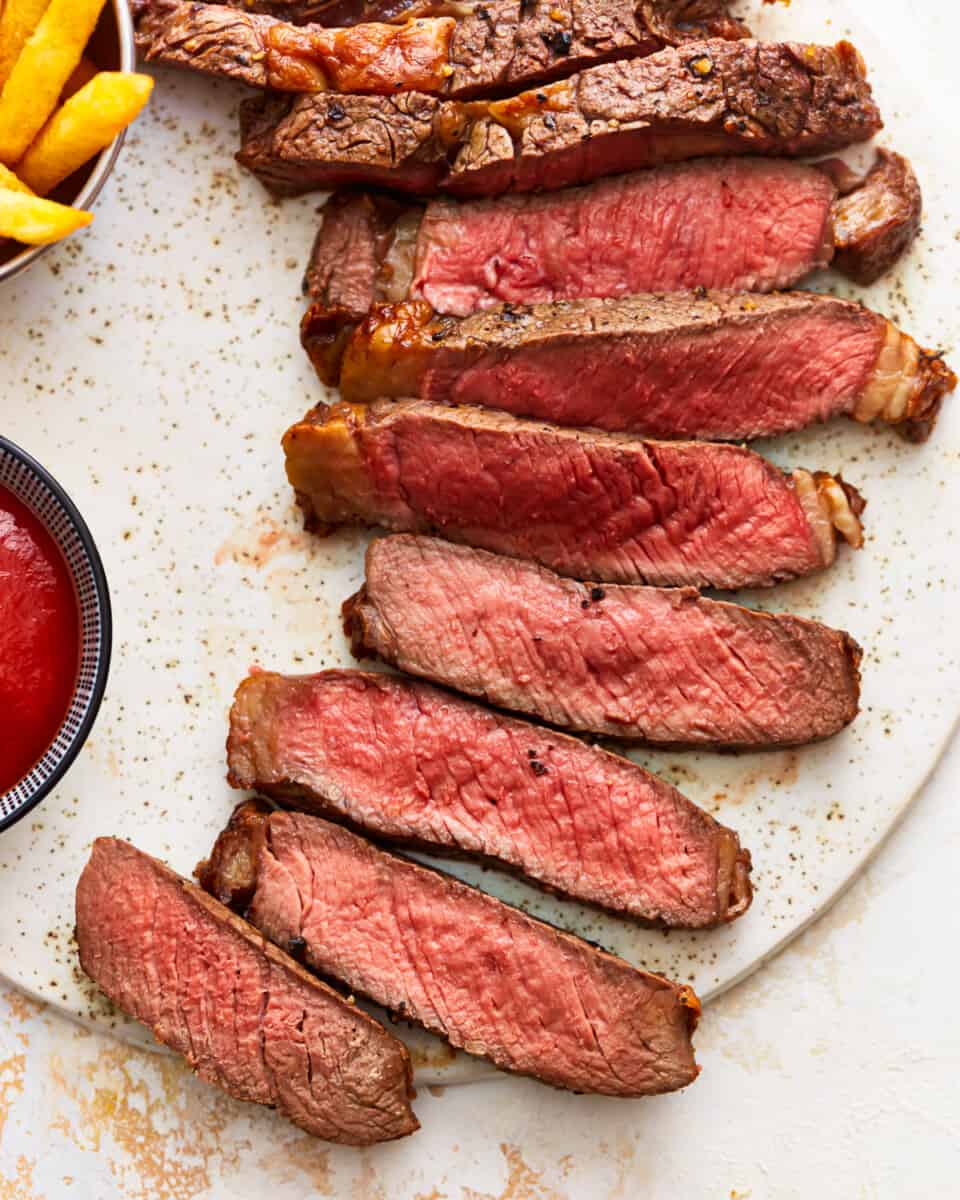
Internal Temperatures for Steak and Beef: 125-160°F
I’ve saved the best for last, steak! If we go to a fancy restaurant, you better believe I’m going to order the filet mignon, medium or medium rare, every single time. I just love a perfectly cooked steak. There’s nothing better!
These temperatures also apply to beef in general, including beef tenderloin, roasts, and other cuts of beef. Check our Burger Temperature Chart for more info if you’re cooking burgers.
It’s generally recommend to cook beef steaks to a minimum temp of 140°F (medium rare). But people like their steaks done at different temps, so there is definitely a range here. Keep your instant read meat thermometer handy!
Beef and Steak Temperature Chart
| Doneness | Temperature |
|---|---|
| Rare | 125-130°F |
| Medium-Rare | 135-140°F |
| Medium | 140-150°F |
| Well-Done | 160°F |
All that’s left is to leave you with a simple and perfect way to grill steak every time. I hope this guide to meat internal temperatures helped, and be sure to print off the FREE printable meat temp chart to keep in your kitchen for easy access. We are so glad you’re here. Enjoy!
Click HERE to get your free printable Meat Temperature Guide for Cooking!
Get Ready to Cook!
Find more cooking guides, resources, how-tos, and printables to keep in your kitchen!
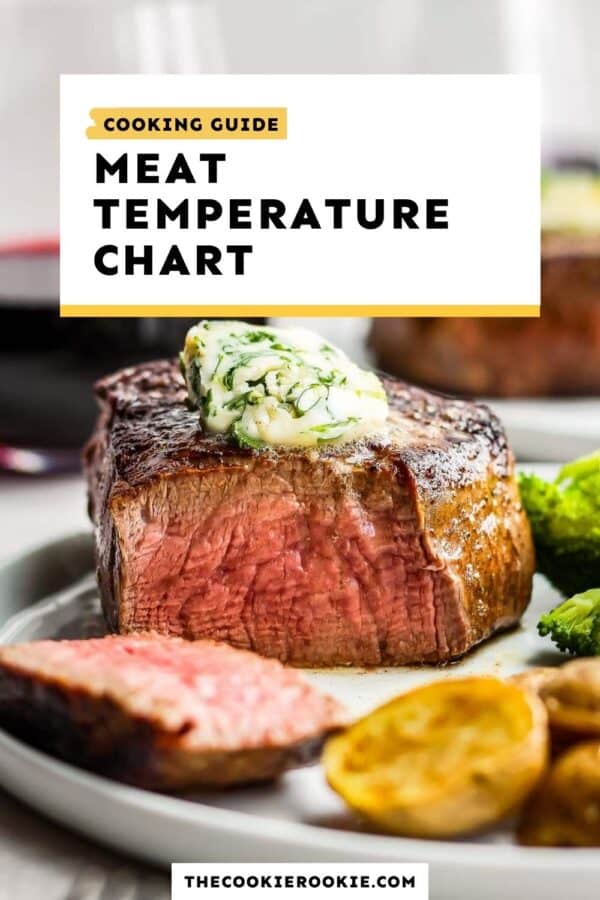
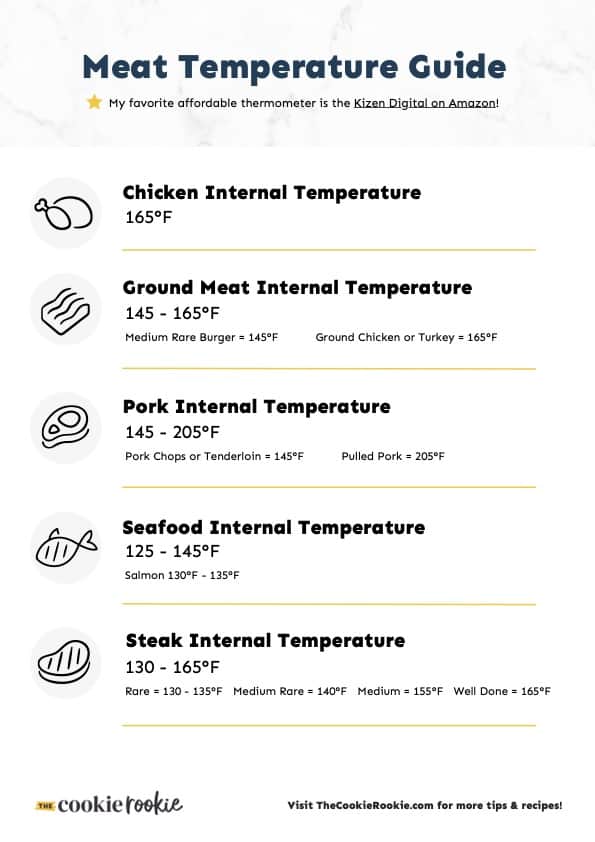
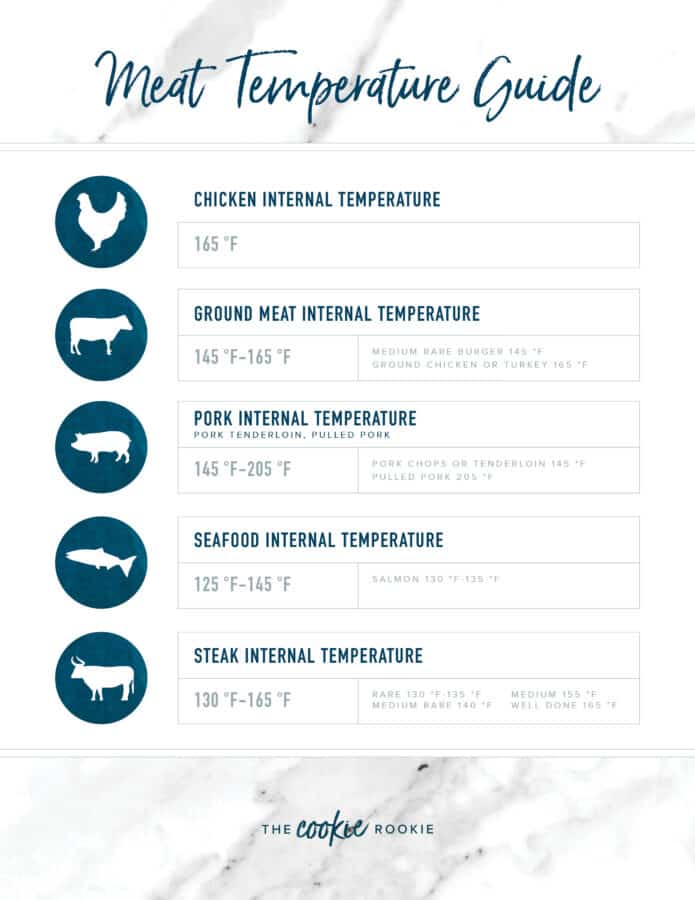
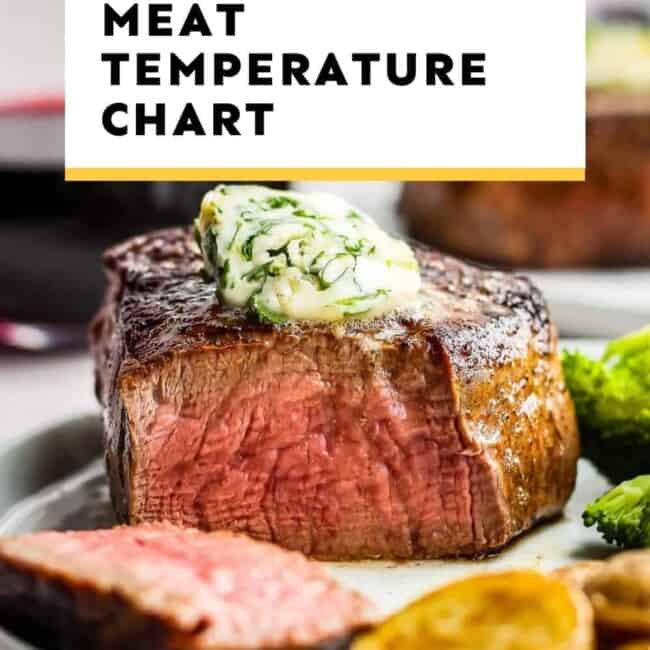
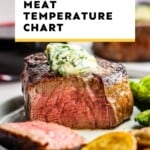


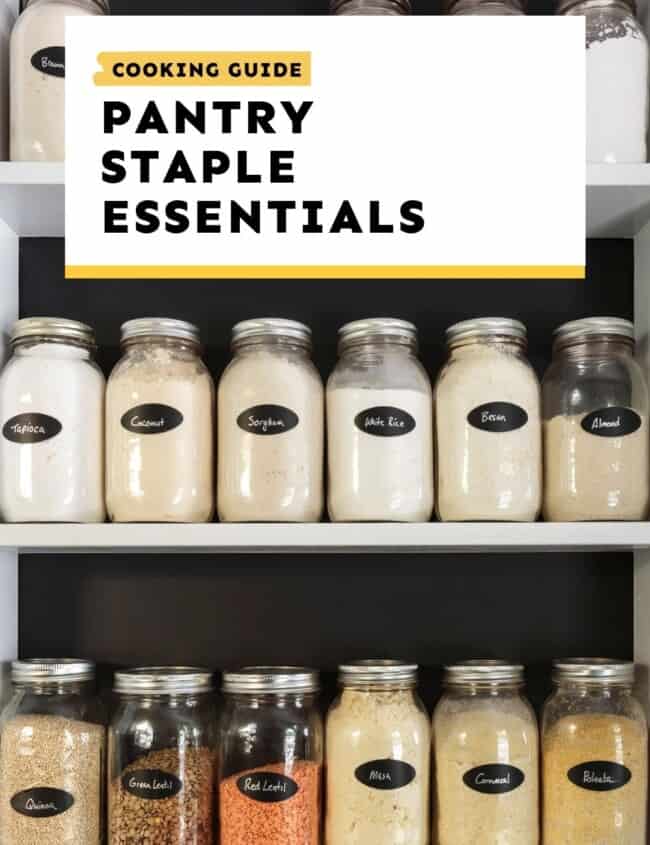








Great article. You spelled Temperature wrong in the chart.
What happen to LAMB???
The lambs grew to be sheep and are living happily ever after
Thank you so much your recipes are the BEST ???? u are a huge inspiration and thank u thank u !!!
Thanks so much Kristyn!